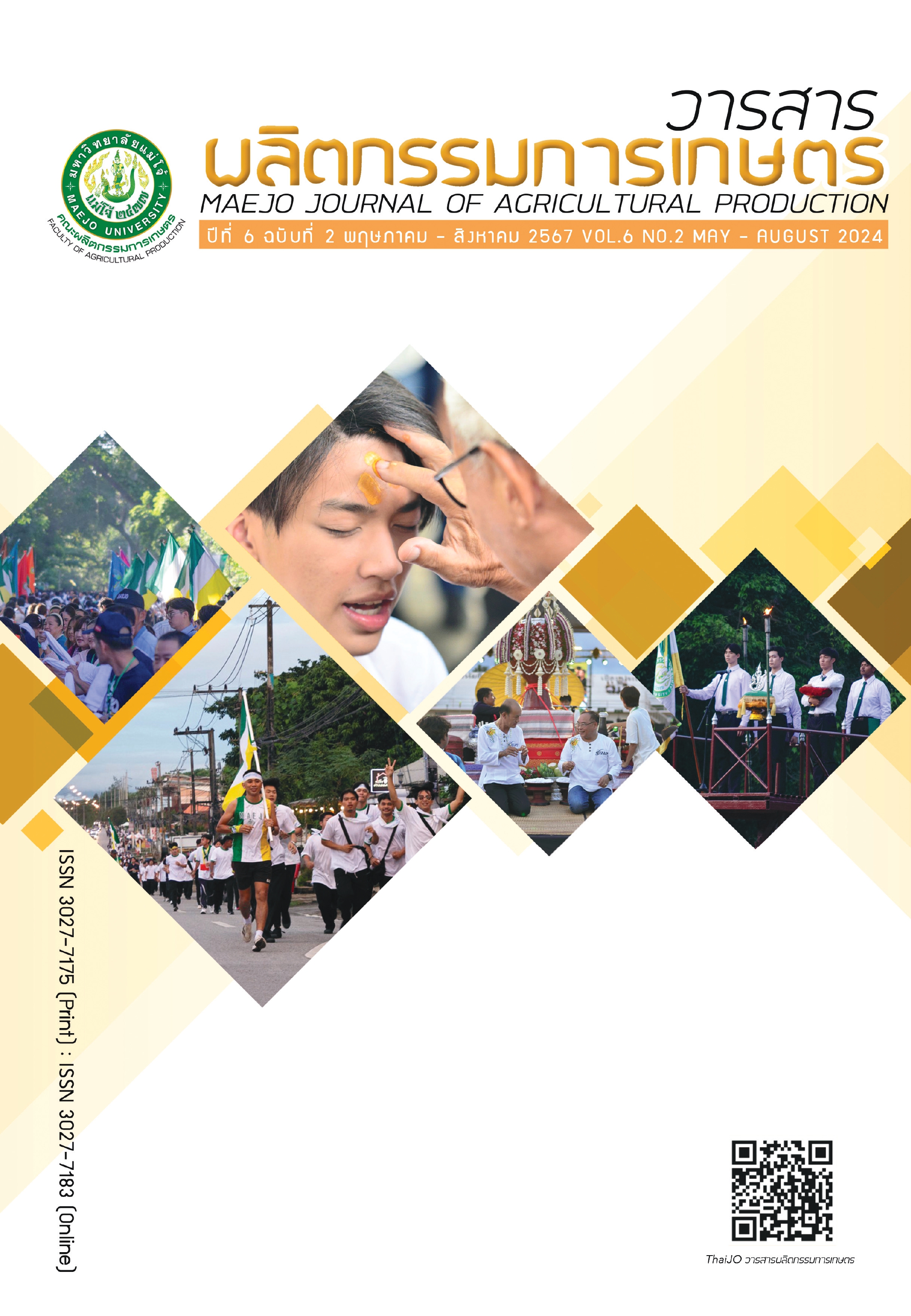ปัจจัยทางสิ่งแวดล้อมบางประการในแต่ละฤดูกาลต่อคุณภาพการผลิตห้อม ในอำเภอเมือง จังหวัดแพร่
Main Article Content
บทคัดย่อ
การศึกษาการเจริญเติบโตและคุณภาพสีของห้อม ระหว่างฤดูกาล นับว่ามีประโยชน์ต่อการปลูกและเก็บเกี่ยวผลผลิตวัตถุประสงค์การวิจัยนี้ เพื่อศึกษาปัจจัยทางสิ่งแวดล้อมบางประการ ในแต่ละฤดูกาล ที่ส่งผลต่อการเจริญเติบโตและคุณภาพสีห้อม โดยใช้วิธีการเก็บตัวอย่างห้อม และดินที่ปลูกของห้อมในสามพื้นที่หมู่บ้าน ได้แก่ บ้านนาคูหา บ้านเเม่ลัวและบ้านนาตอง อำเภอเมือง จังหวัดแพร่ ผลการศึกษาพบว่า ฤดูฝนให้ผลการเจริญเติบโตได้ดีที่สุด โดยเฉพาะห้อมจากพื้นที่บ้านแม่ลัวที่ตั้งอยู่บนพื้นที่สูงจากระดับน้ำทะเล 798 เมตร มีการเจริญเติบโต ด้านความสูงเฉลี่ยเพิ่มขึ้นสูงที่สุด เท่ากับ 71.29 เซนติเมตร แต่ผลของปริมาณตะกอนเปียกพบว่า บ้านนาตองให้ปริมาณสูงที่สุด เท่ากับ 15.93 กรัม และในฤดูหนาวสามารถให้ปริมาณน้ำหนักตะกอนแห้งได้สูงที่สุด โดยเฉพาะบ้านนาคูหา และบ้านนาตอง เท่ากับ 1.21 กรัม การศึกษาการให้คุณภาพของสีห้อมในแต่ละฤดูกาลนั้น พบว่า ในฤดูร้อนให้คุณภาพสีดีที่สุด โดยเฉพาะคุณภาพสีห้อมในพื้นที่บ้านแม่ลัว มีความสว่าง (L*) เท่ากับ 29.22 ค่าความเข้มของสีเขียว (a*) เท่ากับ -8.37 และความเข้มของสีน้ำเงิน (b*) เท่ากับ -1.13 รวมถึงการศึกษาคุณภาพดินบางประการต่อการเจริญเติบโตของห้อม พบว่า ดินในพื้นพี่บ้านนาต้องมีปริมาณฟอสฟอรัส และโพแทสเซียมสูงที่สุด เท่ากับ 51.87 และ 155.12 ตามลำดับ อย่างไรก็ตามบ้านแม่ลัว มีประสิทธิภาพการเจริญเติบโตและคุณภาพสีห้อมที่ดีที่สุด และการส่งเสริมการปลูกห้อมและเก็บเกี่ยวผลผลิตนั้นควรเริ่มปลูกในช่วงปลายฤดูร้อน เพื่อให้ห้อมเจริญเติบโตที่ดีในฤดูฝน และสามารถเก็บเกี่ยวผลผลิตที่มีคุณภาพดีในช่วงฤดูหนาวถึงฤดูร้อน เพื่อให้การผลิตห้อมมีประสิทธิภาพสูงสุด
Article Details

อนุญาตภายใต้เงื่อนไข Creative Commons Attribution-NonCommercial-NoDerivatives 4.0 International License.
เอกสารอ้างอิง
กรมวิชาการเกษตร. 2554. เอกสารสนับสนุน การเก็บตัวอย่างดินเพื่อการวิเคราะห์ ระบบการจัดการคุณภาพ GAP: พืช.กระทรวงเกษตรและสหกรณ์, กรุงเทพฯ.
ณัฐพร จันทร์ฉาย. 2564. หม้อห้อมแพร่: ภูมิปัญญาและนวัตกรรมเพื่อการพัฒนาอย่างยั่งยืน. สมาร์ทโคตติ้งแอนด์ เซอร์วิส, เชียงใหม่.
ณัฐพร จันทร์ฉาย. 2564. หม้อห้อมแพร่ย้อมธรรมชาติเชิงพาณิชย์. สมาร์ทโคตติ้ง แอนด์ เซอร์วิส, เชียงใหม่.
ณัฐพร จันทร์ฉาย และอัญศญา บุญประจวบ. 2564. ผลของความเป็นกรด-ด่างของดินต่อการเติบโตและคุณภาพการให้สีครามของห้อม (Baphicacanthus cusia (Nees.) Bremek.) ในพื้นที่จังหวัดแพร่. วารสารวิจัยนิเวศวิทยาป่าไม้เมืองไทย 5(1): 91-104.
ณัฐพร จันทร์ฉาย อัญศญา บุญประจวบ และณัฐนรี นาระกันทา. 2564. การคัดกรองและการประเมินประสิทธิภาพของแบคทีเรียเพื่อส่งเสริมการเจริญเติบโตของห้อม. รายงานการประชุมทางวิชาการ, 24-25 ธันวาคม. มหาวิทยาลัยแม่โจ้, จังหวัดเชียงใหม่. น. 982-993.
ประนอม ใจอ้าย. 2558. การวิจัยและพัฒนาเทคโนโลยีการผลิตหอ้ มในพื้นที่จังหวัดแพร่. (รายงานโครงการวิจัยปี 2558). กรมวิชาการเกษตร, กรุงเทพฯ.
ประเทศ พลรักษา. 2552. การจำแนกสายพันธุ์ และความสามารถให้ผลผลิตของฮ่อมจากแหล่งต่าง ๆในภาคเหนือของประเทศไทย. วิทยานิพนธ์วิทยาศาสตรมหาบัณฑิต สาขาวิชาพืชไร่, คณะผลิตกรรมการเกษตร, มหาวิทยาลัยแม่โจ้.
พัชรณัฐ ดาวดึงส์ ณัฐพร จันทร์ฉาย และน้ำฝน รักประยูร. 2562. โครงการพัฒนาผลิตภัณฑ์ชุมชนตามหลักการ BEDO’s Concept และสรรหาชุมชนใหม่: กลุ่มผลิตภัณฑ์ผ้าย้อมสีธรรมชาติและไผ่. รายงานฉบับสมบูรณ์. สำนักงานพัฒนาเศรษฐกิจจากฐานชีวภาพ (องค์การมหาชน).
วรรณา มังกิตะ และธนากร ลัทธิ์ถีระสุวรรณ. 2556. การศึกษานิเวศวิทยาและผลผลิตของฮ่อม (Baphicacanthus cusia (Nees) Brem.) ในพื้นที่จังหวัดแพร่. วารสารวิชาการเกษตร 31(1): 26-40.
วิชาญ เอียดทอง และอรไท ผลดี. 2554. สถานภาพและการอนุรักษ์ภูมิปัญญาการใช้สีย้อมจากต้นฮ่อมของกลุ่มชาติพันธุ์เผาไท. วารสารวิชาการเกษตร 5(10): 1-15.
อรุณี คงดี. 2551. การเตรียมวัสดุสิ่งทอก่อนย้อม คู่มือการอบรมเชิงปฏิบัติการการย้อมผ้าด้วยสีจากธรรมชาติ เทคโนโลยีการเพิ่อประสิทธิภาพการย้อมสีจากธรรมชาติ และการเพิ่มสมบัติพิเศษสิ่งทอ. มหาวิทยาลัยแม่โจ้, เชียงใหม่.
Chanayath, N., S. Lhieochaiphant and S. Phutrakul. 2002. Pigment extraction techniques from the leaves of Indigofera tinctoria Linn. and Baphicacanthus cusia Brem. and chemical structure analysis of their major components. CMU Journal 1(2): 149-160.
Teanglum, A., S. Teanglum and A. Saithong. 2012. Selection of Indigo Plant Varieties and Other Plants that Yield Indigo Dye. Procedia Engineering 32: 184-190. Available: https://doi.org/10.1016/j.proeng.2012.01.1255.
Wei, G., Y. Zhang, X.J. Hao, F.M. Yang, Q.Y. Sun, L. Susan, M. Natschke, K.H. Lee, Y.H. Wang and C.L. Long. 2014. Indole Alkaloid Glycosides from the Aerial Parts of Strobilanthes cusia. Journal of Natural Products 77(12): 2590- 2594. Available: DOI: 10.1021/np5003274.
Zhang, H., Y. Zhang and M. Wei. 2010. Comparative Analysis of Climatic Factors between Libo County and Strobilanthes cusia (Nees) O. Kuntze Growth. Medicinal Plant 1(9): 9-11.


